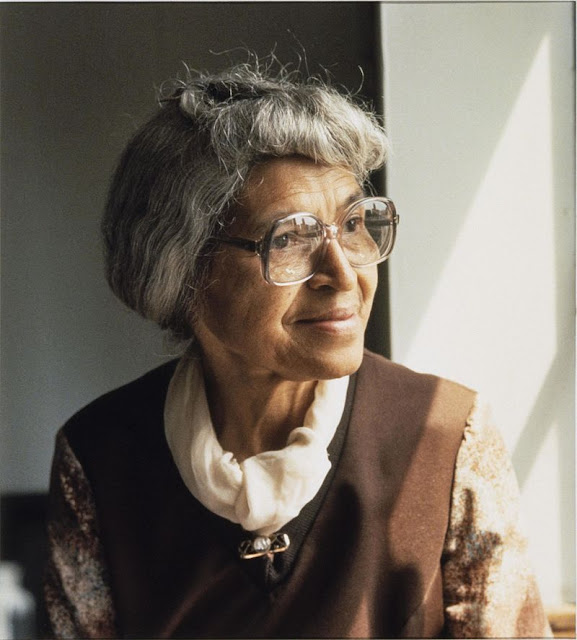Continuing a brief look at the events and persons listed in Billy Joel’s “We Didn’t Start the Fire”.
Each two lines represent a year.
Joseph Stalin, Malenkov, Nasser and Prokofiev
Rockefeller, Campanella, Communist Bloc
Roy Cohn, Juan Peron, Toscanini, dacron
Dien Bien Phu falls, "Rock Around the Clock"
Einstein, James Dean, Brooklyn's got a winning team
Davy Crockett, Peter Pan, Elvis Presley, Disneyland
Bardot, Budapest, Alabama, Krushchev
Princess Grace, "Peyton Place", trouble in the Suez
1956:
Bardot, Budapest, Alabama, Krushchev
Princess Grace, "Peyton Place", trouble in the Suez
Alabama:
On December 1, 1955, in Montgomery, Alabama, African American Rosa Parks rejected bus driver James F. Blake's order to vacate a row of four seats in the "colored" section in favor of a white passenger, once the "white" section was filled.
Parks wasn't the first person to resist bus segregation, but the National Association for the Advancement of Colored People (NAACP) believed that she was the best candidate for seeing through a court challenge after her arrest for civil disobedience in violating Alabama segregation laws. She helped inspire the black community to boycott the Montgomery buses for over a year.
The case became bogged down in the state courts, but the federal Montgomery bus lawsuit Browder v. Gayle resulted in a November 1956 decision that bus segregation is unconstitutional under the Equal Protection Clause of the 14th Amendment to the U.S. Constitution.
Parks' act of defiance and the Montgomery bus boycott became important symbols of the movement. She became an international icon of resistance to racial segregation, and organized and collaborated with civil rights leaders, including Edgar Nixon and Martin Luther King Jr.. At the time, Parks was employed as a seamstress at a local department store and was secretary of the Montgomery chapter of the NAACP.
Although widely honored in later years, she also suffered for her act; she was fired from her job, and received death threats for years afterwards.
Shortly after the boycott, she moved to Detroit, where she briefly found similar work.
From 1965 to 1988, she served as secretary and receptionist to John Conyers, an African-American US Representative. She was also active in the Black Power movement and the support of political prisoners in the US.
After retirement, Parks wrote her autobiography and continued to insist that there was more work to be done in the struggle for justice.
Parks received national recognition, including the NAACP's 1979 Spingarn Medal, the Presidential Medal of Freedom, the Congressional Gold Medal, and a posthumous statue in the United States Capitol's National Statuary Hall.
Upon her death in 2005, she was the first woman to lie in honor in the Capitol Rotunda. California and Missouri commemorate Rosa Parks Day on her birthday, February 4, while Ohio and Oregon commemorate the anniversary of her arrest, December 1.
The United States Congress has called her "the first lady of civil rights" and "the mother of the freedom movement".
Relevance to 1956:
See above, the decision that bus segregation was unconstitutional was delivered in November 1956.
Gallery:
Rosa Parks, 1955, with Dr. Martin Luther King jr in background
Booking photo of Parks following her February 1956 arrest during the Montgomery bus boycott
Police report on Rosa Parks, December 1, 1955, page 1
Parks being fingerprinted by Lieutenant D.H. Lackey on February 22, 1956, when she was arrested again, along with 73 other people, after a grand jury indicted 113 African Americans for organizing the Montgomery bus boycott
Photograph of an empty bus during the Montgomery Bus Boycott.
Rosa Parks c. 1978
Rosa Parks in 1993
The casket of Rosa Parks at the U.S. Capitol rotunda
Rosa Parks statue by Eugene Daub (2013), in National Statuary Hall, United States Capitol
Parks and U.S. President Bill Clinton
The bus on which Rosa Parks refused to give up her seat is a symbol of her defiance that changed the course of history in America. That bus was once in ruins, but now it sits at the Henry Ford Museum in Dearborn. The bus Parks made history in was put out of service in Montgomery in 1971. Eventually, it was put up for auction and the Henry Ford Museum was the highest bidder.
U.S. President Barack Obama sitting on the bus. Parks was arrested sitting in the same row Obama is in, but on the opposite side.
By the way:
- Nine months before Rosa Parks' arrest for refusing to give up her bus seat, 15-year-old Claudette Colvin was arrested in Montgomery for the same act. The city's Black leaders prepared to protest, until it was discovered Colvin was pregnant and deemed an inappropriate symbol for their cause.
- African Americans represented at least 75 percent of Montgomery’s bus ridership. To ensure the boycott could be sustained, Black leaders organized carpools, and the city’s African American taxi drivers charged only 10 cents—the same price as bus fare—for African American riders. Many Black residents chose simply to walk to work or other destinations. Black leaders organized regular mass meetings to keep African American residents mobilized around the boycott.
- Montgomery’s buses were integrated on December 21, 1956, and the boycott ended. It had lasted 381 days.
- Integration, however, met with significant resistance and even violence. While the buses themselves were integrated, Montgomery maintained segregated bus stops. Snipers began firing into buses, and one shooter shattered both legs of a pregnant African American passenger.
- In January 1957, four Black churches and the homes of prominent Black leaders were bombed; a bomb at King’s house was defused. On January 30, 1957, the Montgomery police arrested seven bombers; all were members of the Ku Klux Klan. The arrests largely brought an end to the busing-related violence.
- The Montgomery Bus Boycott was significant on several fronts.
First, it is widely regarded as the earliest mass protest on behalf of civil rights in the United States, setting the stage for additional large-scale actions outside the court system to bring about fair treatment for African Americans.Second, in his leadership of the MIA, Martin Luther King emerged as a prominent national leader of the civil rights movement while also solidifying his commitment to nonviolent resistance. King’s approach remained a hallmark of the civil rights movement throughout the 1960s. Shortly after the boycott’s end, he helped found the Southern Christian Leadership Conference (SCLC), a highly influential civil rights organization that worked to end segregation throughout the South. The SCLC was instrumental in the civil rights campaign in Birmingham, Alabama, in the spring of 1963, and the March on Washington in August of that same year, during which King delivered his famous “I Have a Dream” speech.The boycott also brought national and international attention to the civil rights struggles occurring in the United States, as more than 100 reporters visited Montgomery during the boycott to profile the effort and its leaders.
Some examples of what was being challenged:
Rosa Park's refusal to give up her seat happened only 65 years ago.

























No comments:
Post a Comment
Note: Only a member of this blog may post a comment.